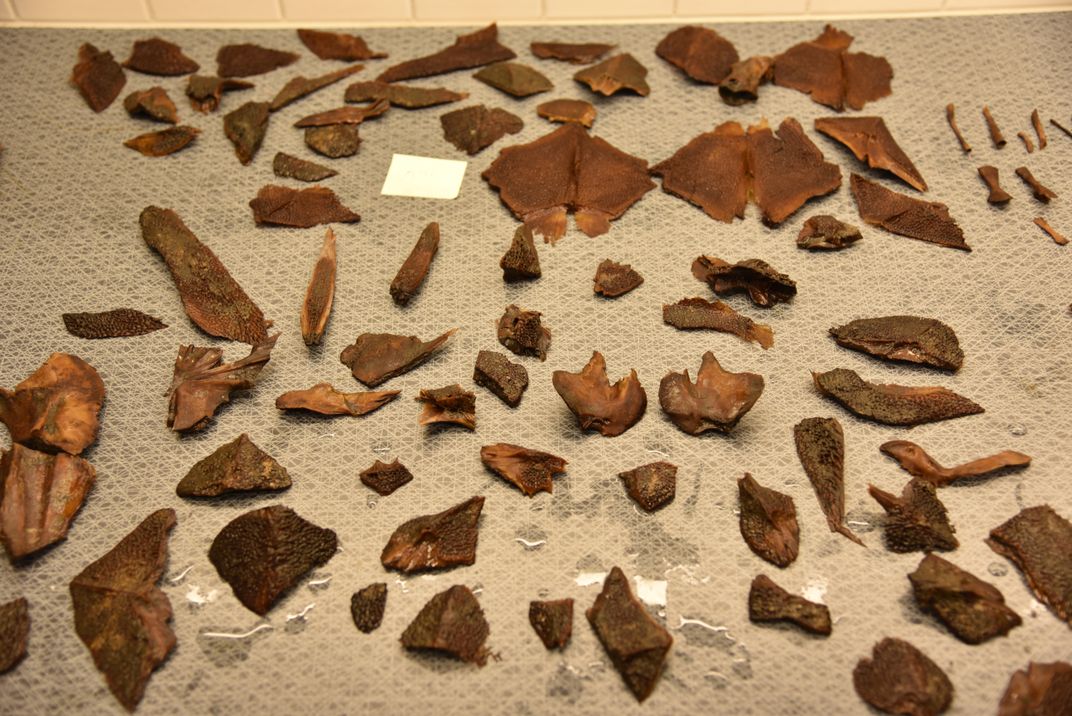Well-Preserved Atlantic Sturgeon Found in 15th-Century Danish Shipwreck
The fish’s remains were stored in a barrel in the royal vessel’s pantry
:focal(517x309:518x310)/https://tf-cmsv2-smithsonianmag-media.s3.amazonaws.com/filer/4e/f3/4ef314af-2653-471c-9f04-713e1dca35fd/2020_sep8_shipwrecksturgeon.jpg)
In the summer of 1495, King Hans of Denmark set sail from Copenhagen on his favorite ship, the Gribshunden. Bound for Kalmar, Sweden, the vessel carried an array of luxury goods meant to impress the Swedes and convince them to join a Scandinavian union with Denmark and Norway.
But while en route to Kalmar, the Gribshunden caught fire and sank. Hans wasn’t aboard when the fire broke out, but numerous crew members died in the ensuing chaos, and the king’s precious cargo was consigned to the watery depths.
Though the accident proved disastrous for Hans’ negotiations with Sweden, the shipwreck itself has been a boon for modern researchers, serving as a time capsule of royal priorities in 15th-century Scandinavia. Now, reports Agence France-Presse (AFP), new research has identified a well-preserved fish recovered from the Gribshunden’s pantry as a rare Atlantic sturgeon. The findings are published in the October issue of the Journal of Archaeological Science: Reports.
Classified as critically endangered by the IUCN Red List of Threatened Species, sturgeons are commonly found along the eastern coast of North America. Their numbers have dwindled due to overfishing and habitat loss, per the National Oceanic and Atmospheric Administration (NOAA).
“For me, this has been a glimpse of what the Baltic Sea looked like before we interfered with it,” says study co-author Maria Hansson, a molecular biologist at Lund University, in a statement. “Now we know that the Atlantic sturgeon was presumably part of the ecosystem.”
Sturgeons have long been valued for their meat and eggs, which are eaten as caviar. The fish’s swim bladders were also used to create glue and gold paint. During the medieval period, the species was so popular that a Danish law decreed all sturgeons found on the shore or caught in the water property of the king.
Archaeologists spotted the sturgeon’s well-preserved remains while conducting excavations in 2019. Its bony external plates, or scutes, were scattered in and around the barrel in which crew members had stored their bounty. The team initially suspected that the fish was a type of European sturgeon, but DNA analysis identified it as an Atlantic sturgeon.

Analysis of skull bones and scutes showed that the fish measured about six and a half feet long. It was butchered before being placed in the barrel and, unlike sturgeon prepared today, was neither cleaned nor filleted.
“Since most of the Gribshunden remains are scutes, the … fisherman obviously did not follow this modern cleaning procedure,” the researchers write in the paper. “It is possible that the standard butchery procedures were different, or that the crew and passengers aboard the ship at the time were unfamiliar with the species.”
The authors add that the fish could have been caught by chance during the voyage. Upon recognizing the fish’s high value, Hans might have insisted the crew preserve it to add to his hoard of expensive goods.
“We interpret the fish not so much as a gift but as a prestige display,” co-author Brendan Foley, an archaeologist at Lund University, tells AFP.
He adds, “One possible interpretation, and the one we like best considering the political nature of the entire voyage, is that it is part of Hans’ effort to subtly influence the Swedish nobles to join the Nordic union.”
When the Gribshunden sank, Hans lost that source of influence. It took another two years for the Scandinavian countries to unite under the Danish leader, according to the Crafoord Foundation, which funded the recent excavations.
Swedish scuba divers found the historic shipwreck in the 1970s. Though local divers proceeded to scavenge small artifacts such as lead cannonballs and fragments of ceramic and metal items, the vessel itself remained unidentified until 2001, when divers informed the nearby Kalmar Museum of its presence. Bacteria had eaten away at the iron artifacts onboard, but wooden artifacts, including the masthead of a griffin-dog chimera holding a person’s head in its mouth, remained intact.
“The wreck is in such good condition because of the strange Baltic environment,” Foley tells AFP. “The low salinity here is unsuited for shipworm, which eat wood in the world’s ocean system. The sea floor is a fine clay, ideal for preserving organic material, and low dissolved oxygen levels further contribute to preservation of organics.”
According to the Crafoord Foundation, more than 99 percent of the Gribshunden wreck remains unexplored. As research continues, the archaeologists expect to find chests of fine clothing and other luxury items that belonged to the Danish noblemen traveling onboard.